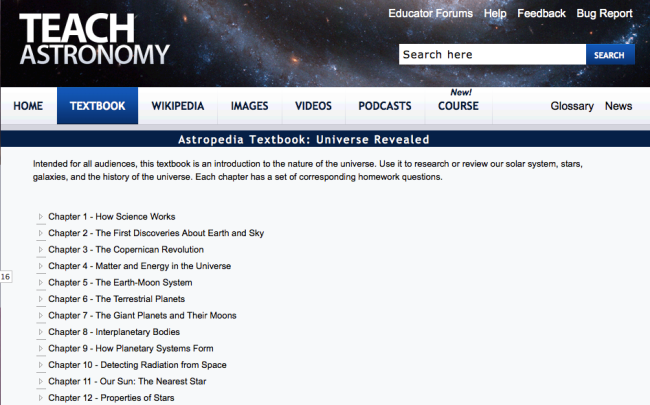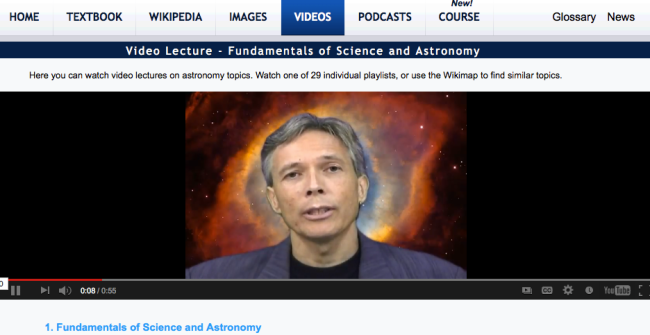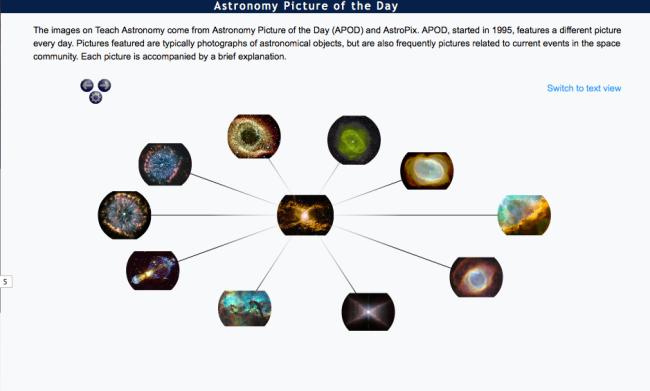My first real investigation of online leaning is of the site teachastronomy.com.
I am lucky enough to personally know a developer of the educational site, so I arranged an interview I could obtain a better understanding of what the website is for and who its target audience is. I’ve never personally been the “interviewer” before, so I asked my good friend Carmen Austin, who works on the project, to talk to me as if she was giving a poster presentation at a large conference, of which she has attended many. Here we go!
Summarizing Carmen: Teach Astronomy is intended to act as a learning tool for those who want to learn more about astronomy. The intended audience is for people who are in college or at a community college, but do not necessarily have to be astronomy majors. However, anyone who needs an astronomy resource can use this site (such as informal learners of all ages or amateur astronomers) as it is free and available to anyone who wishes to expand their knowledge in the astronomical sciences. Here are ways the site can be utilized in the classroom: I will begin by listing content, and then branching off into the categories and explaining them in further detail. I will label my thoughts in a different color to separate Carmen’s thoughts from my own.
Content:
- Free Textbook
- Wiki Articles
- Video Lecture Series
- Image Databases (APOD, Astopics)
- Podcasts
Texobook: Yes, I did say free. This tool is designed to supplement or even replace other textbooks with equally high quality teachings that cost money to obtain. Teachers who use the site can assign readings from this online textbook. Students and teachers alike may find these convenient because the readings are easy for the students to find. The instructor can post direct links to the assigned pages through email, the class website, D2L (Desire 2 Learn), Black Board, or any other service. Also, students may appreciate the fact that the textbook is no cost to them. There are so many benefits to having a free online textbook because it supplies a tool for learning for those who do not have access or cannot afford educational reading material. The public library can provide internet for them to obtain the required information, so no one is denied the opportunity to learn because they could not afford it.
Wiki Articles: Many of the astronomy related articles on Wikipedia are gathered under one tab so the students have an easier way to access additional resources other than Teach Astronomy. I know many teachers don’t support Wikipedia as a site for reliable information, but personally, I believe Wikipedia is one of the BEST sites because, sure, people can alter information on it and make it false, BUT BECAUSE, people can edit the articles, readers see wrong information and therefore CHANGE it to be correct. So many people visit these articles per day, the chances of someone correcting wrong information is pretty high compared to someone visiting a private site and not being able to edit misleading info. AND the number of “internet trolls” out to sabotage this site (I’m guessing) is much less than those who want to learn and improve it).
Video Lecture Series: There are a series of video playlists that provide even more information on various astronomical subjects. The video recordings of Chrisy Impey, author of the textbook, are are broken down into certain topics labeled by the general topic presented in the videos. Students can also access these through a visible tab on the main page.
Image Databases: For those who are interested in browsing really cool images of astronomical objects, they can click on another link that will take them to other webpages such as Astronomy Picture of the Day (APOD), and Astropics. These are updated frequently, so there is always something new to look at. These are great because I, myself enjoy viewing pretty pictures of nebulae, planets, and other visually pleasing ojbects. I know APOD also gives a short description of the relevance of the image they post. I find myself learning cool information on these sites I didn’t know beforehand.
Podcasts: Another access to information in the astro science world are Teach Astronomy’s links to podcasts from “365 Days of Astronomy.” The site gives the description: 365 Days of Astronomy has been publishing one podcast per day since January 1st 2009. The podcasts are created by many astronomers all over the world.
Other aspects of the site that are useful for navigation and understanding are:
The Browsing Tool: This tool is mainly connected to the Wiki Articles that provide additional information on many topics mentioned in the textbooks. When you search something, the search results are displayed in one of two different ways. First, there is a “Wikimap” that displays in the center the article of most relevance to the search. The articles connected around it, are also relevant, but may be sub-topics of the item that was searched. The user then chooses which article they want to read, and they are directed to the Wikipedia article of choice. Many of the screenshots above display this “Wikimap” style of user interface. For those who do not favor this display, they can switch to a regular text view much like a Google search.
The Glossary: This is one of the most useful tabs on the site because it explains hundreds of astronomical terms described in the textbook and many of the other resources. What’s nice is that whoever reads the textbook is not forced to visit the actual glossary page if they do not understand a word. If the word in the text is the color red, they can hover their pointer over the word, and a definition pops up, explaining the meaning.
The News Updates: Part of understanding astronomy, is knowing what’s new in the astronomical world today. There is a link in the bar that navigates the student to an rss reed of ten to thirty of the most recent news articles from sciencedaily.com.
Forums for Educators: This is a very useful took for teachers and for the developers of Teach Astronomy. To participate in the discussion forum, teachers can sign up and talk to other teachers about how they use the site as well as how the site can be improved. There are links provided for instructors to give feedback as well as bug reports. The delevelopers of Teach Astronomy are always looking for ways to improve the site so it can continue to provide tools for learning for days to come.
For People Who Cannot Hear this is a great way to access information because the majority of the content can not only be heard, but can also be read. The videos are accessible through YouTube, and the subject is written in the description box below the video. For those who can read lips can also understand what Chrisy Impey is saying, because the video shows him speaking. The podcasts are also written out so no one who can’t hear misses out on those either. I am wondering how those without site can learn from Teach Astronomy… Perhaps I can submit a suggestion to Carmen and the others to see if there is a way they can make it accessible to the blind as well.
Keeping Track of Stats: To keep track of how many people use the site, the team uses Google Analytics. With this tool, they can keep tabs on the site usage, even live where they can see in real time how the site is being used and which links are the most popular. Stats are kept on how many visits the site gets per week, the location of the users of the sites, like what cities it is most popular in. Also, it can keep track of links to Teach Astronomy from other websites, to see where the traffic comes from the most.
The Future of Teach Astronomy: Chris Impey, the founder, has exciting plans for Teach Astronomy. He is actually instructing an online class through udemy.com, a site for online classes, where thousands of people register for online classes to learn any subject of choice. There are currently four hundred and twenty one people signed up to take this course which will be supplemented by Teach Astronomy. This is the first time the team has ever tried to teach a full online course, so they are excited to learn from this experience and welcome any feedback from their students. I have looked up the class and here is the link: https://www.udemy.com/astronomy-state-of-the-art/ . Many of the courses available on udemy.com cost money, but as always, the team has made their course free and available to anyone who wants to learn.
Conclusion: Thank you to Carmen Austin for giving me so much awesome information on Teach Astronomy. I think making astronomy accessible to anyone is truly amazing. They have great ideas and lots of content that can provide valuable information to those who seek it. I plan on exploring the site myself and giving a review on it in my next blog post within a week or so, so stay tuned!






